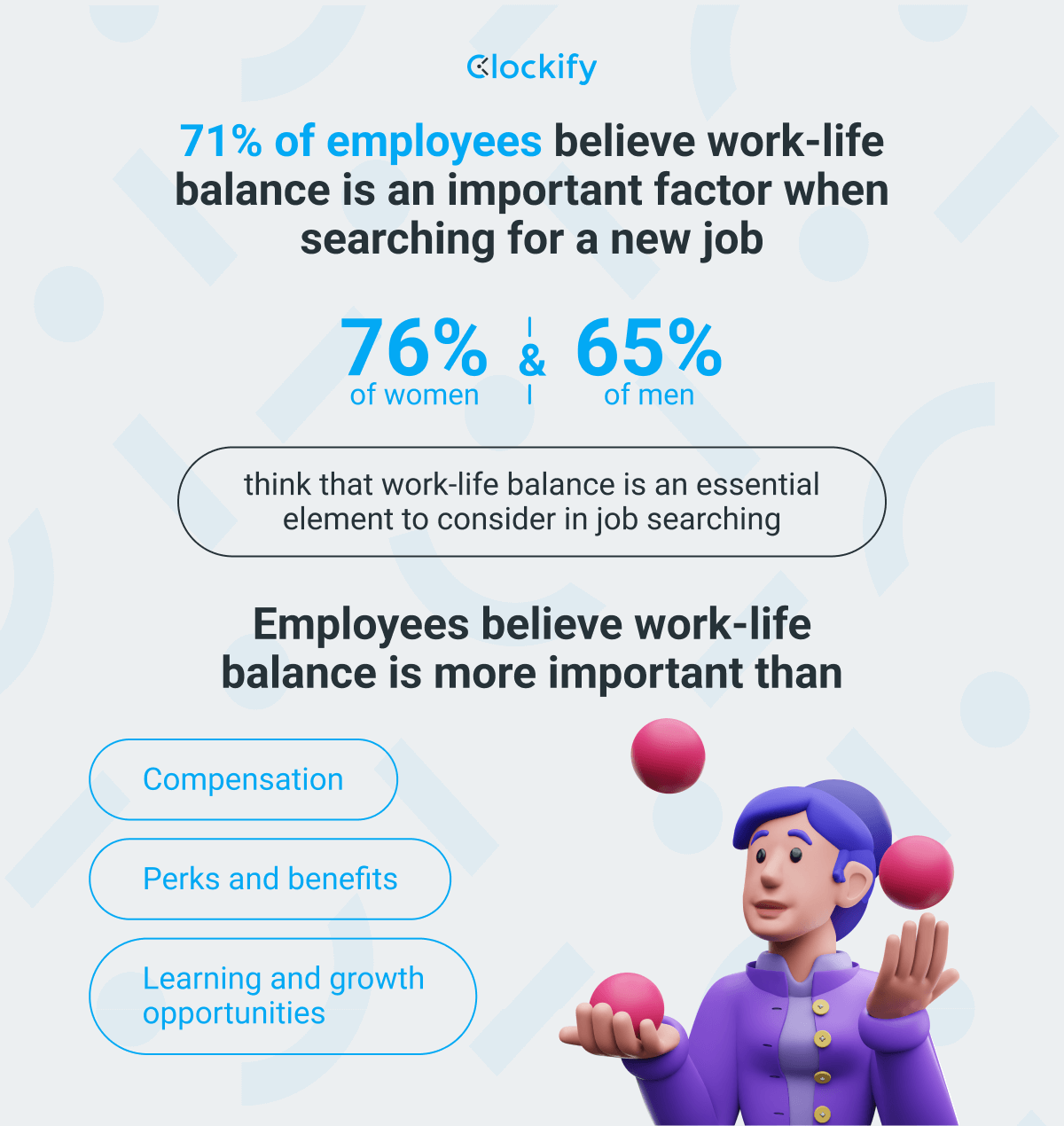Jeff Bezos, Founder of Amazon, emphasizes the concept of work-life harmony over balance: “I like the phrase ‘work-life harmony’ better because I know that if I am happy at home, I come into work with tremendous energy. And if I am happy at work, I come home with tremendous energy.”
Maintaining a proper work-life balance is not just a perk; it’s a strategic element that significantly impacts employee retention and satisfaction. This article explores how fostering a strong work-life balance is pivotal in maintaining high levels of employee engagement, offering practical strategies for enhancing productivity and retention.
Read more about Best Employee experience practices on AceNgage website.
The Importance of Work-Life Balance
“Microsoft Japan reported a 40% increase in productivity after testing a four-day workweek.”
Work-life balance is crucial for both employees and employers. A balanced approach to work and personal life brings numerous benefits, including improved mental health, greater job satisfaction, and increased productivity. For organizations, it leads to a healthier work environment, reduced turnover rates, and a more resilient workforce.

Source – Clockify
Life Balance to Work
The concept of work-life balance is evolving into work-life integration, reflecting changes in work environments and cultural attitudes. This shift recognizes that work and personal life are not always neatly separable but can be integrated in ways that enhance both. Effective integration strategies include flexible working hours, remote work options, and supportive company policies that allow employees to blend work with personal responsibilities smoothly.
As technology advances and the digital workspace becomes more entrenched in our daily lives, the boundaries between work and personal time blur further, making work-life integration not just a possibility but a necessity for many. This new paradigm shift encourages a holistic approach to employee wellness, recognizing that a well-rounded life can contribute to sustained productivity and creativity at work. Companies that embrace this concept often see increased employee satisfaction and loyalty, as individuals feel supported in their personal goals and responsibilities. This integration not only benefits employees but also enhances the organization’s ability to attract top talent who value flexibility and a supportive work culture.
33 Work-Life Balance Examples to Improve Productivity
Here are 33 practical initiatives that companies can implement to enhance productivity through better work-life balance:
- Flexible working hours
- Remote working options
- Mandatory vacation time
- Wellness programs
- Childcare support
- Fitness subsidies
- Mental health days
- Employee assistance programs
- Regular health screenings
- Professional development opportunities
- No-email weekends
- Team bonding activities
- Performance incentives that promote balance
- Encouraging hobbies and personal projects
- Sabbatical leave
- Job sharing schemes
- Family-friendly workplace events
- Enhanced parental leave
- Employee autonomy in task management
- Clear boundaries between work and home time
- Stress management workshops
- Time management training
- Lunch and learns on personal development
- Employee recognition programs
- Community service days
- Financial planning resources
- Health and wellness fairs
- Regular career counseling
- Support for back-to-school employees
- Retirement planning assistance
- Legal assistance services
- Transportation benefits
- On-site relaxation spaces
Each of these initiatives is designed to support employees in managing their work and personal lives effectively, thereby boosting overall morale and productivity.
Employee Engagement and Work Balance
“According to a Gallup poll, companies with high employee engagement report 21% higher profitability.”
Linking employee engagement with work-life balance illustrates how one supports the other. A well-balanced employee is typically more engaged, showing higher levels of enthusiasm, commitment, and motivation towards their work. Conversely, promoting engagement through recognition, growth opportunities, and supportive leadership further enhances employees’ ability to maintain work-life balance.
The statistic from the Gallup poll underscores the significant impact that employee engagement can have on a company’s bottom line. Engaged employees are often more motivated and invested in their work, which translates into higher productivity and efficiency. This increased productivity naturally leads to better service, higher customer satisfaction, and ultimately, increased profitability. Moreover, when employees are engaged and supported through well-thought-out work-life balance initiatives, they tend to have lower absenteeism and turnover rates, reducing the high costs associated with recruiting and training new staff. Thus, the correlation between employee engagement and profitability is not only intuitive but strongly supported by empirical evidence, highlighting the importance of fostering an engaging work environment that supports personal well-being.
How to Boost Employee Engagement with Work-Life Balance
Organizations can leverage work-life balance principles to boost employee engagement by implementing policies that promote a healthy balance and recognizing employees’ needs outside of work. Tips include:
Indra Nooyi, former CEO of PepsiCo, has said: “You can’t have it all at once. You can have a lot of fun with your family, you can have a very fulfilling job, but you can’t do everything at the highest level all at once.”
- Implementing flexible working policies that cater to different life stages and responsibilities.
- Encouraging managers to lead by example in maintaining their own work-life balance.
- Regularly reviewing workload and work hours to prevent burnout.
- Creating a culture where taking personal time is not only accepted but encouraged.
Factors of Employee Engagement: Work-Life Balance
Work-life balance is a critical factor in employee engagement. Balancing professional and personal lives affects engagement levels by influencing employees’ attitudes towards their job and employer. Effective balance reduces stress and prevents job burnout, thereby fostering a more engaged and productive workforce.
Influence on Attitudes: Balancing professional and personal lives significantly affects employees’ attitudes towards their jobs and employers, enhancing their overall engagement and commitment.
Stress Reduction: An effective work-life balance helps reduce workplace stress, which can otherwise lead to burnout and disengagement.
Prevention of Burnout: By managing workloads and providing time for personal activities, companies help prevent employee burnout, maintaining a healthier, more engaged workforce.
Productivity Boost: Employees with a good work-life balance often exhibit higher productivity, as they are more focused and energized during work hours.
Enhanced Engagement: Work-life balance is a key factor in fostering a deeply engaged workforce, as employees feel their personal needs and well-being are valued by their employer.
Real-Life Examples of Work-Life Balance from Top Companies
Google is renowned for its employee-friendly policies that heavily emphasize work-life balance. They offer perks such as on-site childcare, comprehensive health services, and flexible work hours. Google’s focus on employee wellness significantly contributes to its consistently high rankings as one of the best places to work.
Netflix
Netflix has adopted a unique approach by offering unlimited vacation days to its employees, trusting them to manage their own time off without compromising their work output. This policy promotes responsibility and emphasizes results over hours worked, aligning with a culture of freedom and flexibility.
Slack
Slack has implemented “Friyays,” where employees have the option to take every other Friday off. This initiative helps employees recharge and spend more time with their families or on personal projects, contributing to overall job satisfaction and productivity.
Salesforce
Salesforce offers six days of paid volunteer time off (VTO) annually, encouraging employees to engage with their communities. Additionally, they provide benefits like wellness reimbursement, which can be used for fitness classes, gym memberships, or other health and wellness activities. Salesforce’s focus on both community engagement and personal health enhances overall employee engagement.
Conclusion
This article has explored the multifaceted relationship between work-life balance and employee engagement. As we have seen, integrating effective work-life balance strategies is essential for enhancing employee engagement and retention. In a world where the demands on employees are ever-increasing, creating a supportive environment that fosters a healthy balance between work and personal life is not just beneficial but necessary for sustained organizational success.
Need information on AceNgage Employee Engagement Service, Contact us.
FAQ on Work-Life Balance
How Important Is Work-Life Balance for Employee Retention
Here, the connection between work-life balance and employee retention rates will be examined, highlighting how organizations can reduce turnover by creating more balanced working environments.
How does work-life balance affect employee engagement?
An in-depth analysis of how work-life balance impacts employee engagement, including insights from recent studies and expert opinions.
Why is work-life balance important for employee retention?
Exploring the reasons behind the significance of work-life balance in retaining top talent, with statistical evidence and real-life examples.
What is employee engagement, and why is it important?
A foundational look at what constitutes employee engagement, its dimensions, and its undeniable importance in achieving organizational success.
How can observation help improve employee engagement?
Discussing the role of observational strategies in identifying engagement opportunities and challenges within the workplace.
What is employee engagement in HRM?
Defining the role of employee engagement within Human Resource Management and how HR practices are tailored to enhance engagement.
How can leaders achieve high employee engagement?
Outlining leadership techniques that are proven to foster a culture of high employee engagement, including communication, transparency, and recognition strategies.
Does employee engagement really drive results?
A critical examination of the link between employee engagement and business outcomes, supported by data and case studies.
How to conquer the growing employee engagement crisis?
Addressing current challenges in employee engagement with innovative solutions and proactive measures to engage a modern workforce.
What are the best employee engagement activities?
Listing and detailing effective activities that can boost employee engagement, from team-building exercises to professional development sessions.
What can managers do to improve employee engagement?
Advice for managers on actions and strategies that can significantly enhance engagement levels among their teams.
What are the latest trends in employee engagement?
A look at emerging trends and innovations in employee engagement, incorporating technology, wellness programs, and flexible work arrangements.
How much do companies spend on employee engagement?
Analyzing investment trends in employee engagement initiatives, including budget allocations and ROI discussions.
Why engaging employees at work always poses a dilemma?
Exploring the complexities and challenges of engaging employees, including balancing differing individual needs and organizational goals.
How can businesses encourage employee engagement?
Suggestions for businesses on fostering an engaging work environment that encourages employees to invest fully in their roles.









